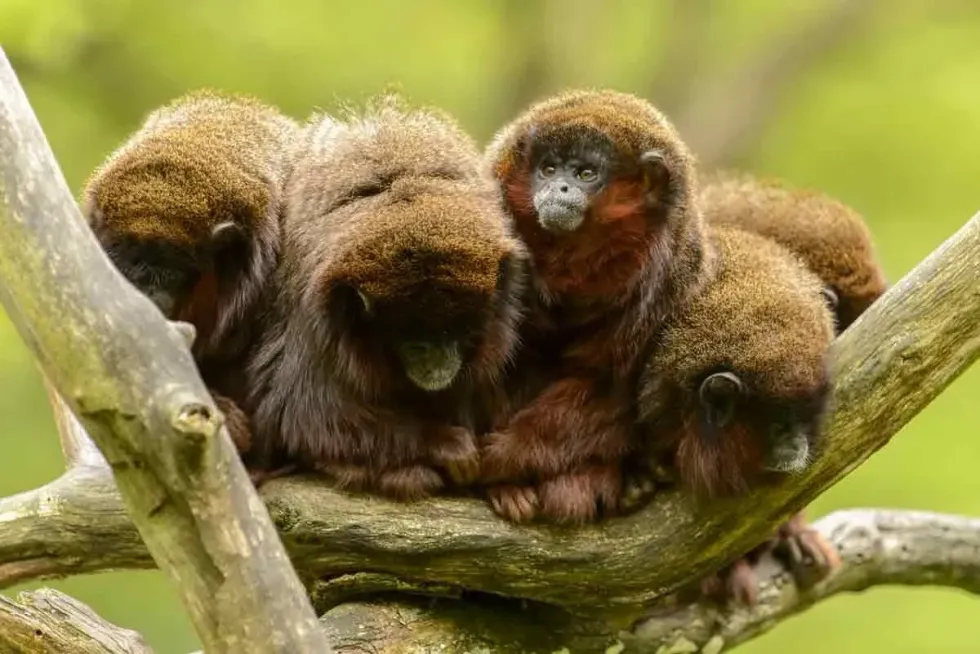The titi monkey is a small New World monkey. Their conservation status is endangered. There are a total of 20 different species of titi monkeys.
Some are named after their coloration and body size. They are found primarily in eastern Bolivia in forests and swamps and the basins of the Mamore River as well as the Rio Grande. This species of titi monkey is endemic to Columbia.
Males of the species are only slightly bigger than females but appear the same. Titis have long prehensile tales, like those of the wooly monkeys.
They rarely come on the forest floor and spend the majority of their lives in the trees. They move through the forest by leaping between the trees, and quadrupedally when they are on the ground.
They rest for long hours in dense areas of vegetation. This species of titi monkey is territorial and often displays vocalizations in order to mark their territories as well as protect them from others.
In this article, we will take a look at some interesting facts and information related to the species of titi monkey. If you liked this article, then check out the guenon and the squirrel monkey.
Titi Monkey Interesting Facts
What type of animal is a Titi Monkey?
The titi monkey is a type of monkey that is known for its prehensile tail and primarily consumes fruits, leaves, and seeds as well as certain species of insects.
What class of animal does a Titi Monkey belong to?
Titi monkeys belong to the Mammalia class of animals. They also are playful beings and engage in activities like chasing, biting each other, and wrestling.
How many Titi Monkeys are there in the world?
There are a total of 20 different species of titi monkeys. The exact number of titi monkeys in the world is not known.
Where does a Titi Monkey live?
They live in forest areas, and swamps near the Amazon river, and other rivers. They are active throughout the daytime and usually spend the most time in the trees. They also socialize with other family members. In Brazil, they are found in indigenous reserves.
What is a Titi Monkey's habitat?
Since they primarily feed on fruits, leaves, seeds, and insects they reside in forest areas and swamps and forage in small groups and eat throughout the day. They rest during the day and are active during the other times of the day, particularly around dawn and dusk.
Apart from forests and swamps, the titi monkey's habitat is also seen in certain national zoos, such as the Smithsonian national zoo located in Washington D.C.
Who do Titi Monkeys live with?
Titi monkeys live with their own kind in the wild together. Family groups are strongly territorial. Grooming is a bonding activity for these monkey species which they do during the mid-time when they rest. Intertwining their tails is a symbol of bonding between male and female species.
How long does a Titi Monkey live?
Titi monkeys can live up to 20 years. The oldest monkey that ever lived was Puan an Orangutan who lived for 62 years.
How do they reproduce?
Titi monkeys are monogamous. They reside in close proximity to one another and live and sleep together.
When they are apart from each other they express emotions of stress and anxiety. They also become jealous if their mate is approached by a stranger. Female titi monkeys give birth to a single offspring after a gestation period of 160 days.
They give birth in the months of November to March. The young titi monkeys are weaned at around eight months of age. Male titi monkeys help care for the baby when the female is not feeding them by carrying them.
Juveniles leave their family group after two or three years. Their family size can range from two to five individuals, including the mated pair.
What is their conservation status?
The species is classified as Endangered by the IUCN the International Union For Conservation Of Nature (IUCN). The Bolivian titi monkey conservation status is recorded as of Least Concern. The conservation status of coppery titi monkey as categorized by the IUCN is also listed in the Least Concern category.
Titi Monkey Fun Facts
What do Titi Monkeys look like?

There exist various species of titi monkeys and all vary in coloration and body size. However, there are certain features that are common and can help you identify them.
Their tails may include black or grey coloring. Their head and body length is typically 13 inches (32cm). Their tails are an additional one-third to one-quarter of their body length.
There are a total of 20 species of titi monkeys and all differ in coloration and body size. For example, Bolivian titi monkeys are white-eared and brown and orange in color different from other species of titi monkeys.
How cute are they?
All titi monkeys are equally cute and unique in their appearance as well as their colors. They are active, playful, and protective of their territories. They are known to express aggression towards other family groups that are potential competitors. Bolivian gray titi monkeys play an important role in bringing tourists to the forested areas of Bolivia.
How do they communicate?
Titi monkeys are more vocal than most Neotropical primates. They have complex vocalizations as compared to most other monkeys. they have a loud territorial call composed of series of short sequences of noises chirrup-pump and can be heard for 1.6 miles. They are silent during territorial calls. Pairs of titi monkeys engage in duets with other pairs during dawn.
How big is a Titi Monkey?
Titi monkeys are 13 inches (33cm) in length which is a lot bigger than the adult pygmy marmosets which are the smallest species of monkey.
How fast can a Titi Monkey move?
Red titi monkies move quickly but they do so only when necessary and stay within a small area feeding on fruits, seeds, certain leaves and certain species of insects. The Patas monkey is considered to be the fastest of all primates.
How much does a Titi Monkey weigh?
Titi monkeys approximately weigh 1.5-4.5lbs. Their fur color can range from red, brown, gray, or sometimes even black. Their body size and coloration may depend on the particular species of titi monkey.
What are their male and female names of the species?
Males and females don't have any specific names and are addressed by the same name. There is a difference in their anatomical structures which helps distinguish the two from each other.
What would you call a baby Titi Monkey?
A young titi monkey is referred to as an infant and is carried by their mother for 20 % of the time in the first month, after which maternal contact is rare. During this time they are likely to experience elevated heart rates, stress when being separated from their fathers or mothers.
Adults have a stronger bond with their mates than with their infants.
What do they eat?
The titi monkey's diet includes fruits, leaves, bird eggs, and certain insects as well. Depending on the weather, their daily foraging can be significantly shorter or longer. They eat throughout the day with one break at mid-day.
Predators of titi monkeys include snakes, eagles, and hawks. Baby species of titi monkeys are also likely to fall prey to tufted capuchins. All species of titi monkeys make use of their coloration to blend into their surroundings and avoid problems.
Are they loud?
The species of titi monkey is a vocal being and can be loud depending on the situation they are in. They live with other primate species and are extremely protective of their territory and may end up fighting if other primate species invade their space.
Would they make a good pet?
Titi monkeys are wild animals and it's best for them to reside in their habitat to survive. They should not be in captivity. They are wild animals it is not appropriate to consider keeping them as pets.
Did you know...
They are hunted by people as a source of food which is damaging to their survival. There are about 90 titi monkeys living in zoos around the world.
A group of monkeys moving together is referred to as a tribe, troop, or mission. There are two major types of monkeys, one that lives on the ground, and the others who are tree-dwelling.
Titi monkeys have been seen chewing leaves and rubbing the pulp on their chest. The exact reason for this behavior is not known.
Are they loud?
They have two types of calls depending on the need for their communication. Loud calls in particular are heard in high amplitudes with low frequency.
They have different loud calls and the diurnal pattern varies from one species to another. They are noisy howlers with high amplitude. The second is a quit call which they make around possible predators to avoid being caught.
What are their adaptations?
Male titi monkeys use their long prehensile tails to grasp or hold onto things. They also have an extremely elaborate form of communication, including vocalizing, smelling, and gestures.
The Bolivian gray titi monkey is adaptable and has a low level of natural predators.
The dusky titi monkey is one of the most populous monkeys and is sexually dimorphic, meaning they don't look different physically but have differences only in reproductive functions.
All species of titi monkeys are important for the sustenance of wildlife as they are essential in balancing the ecosystem by being an important part of the food chain, for both their prey and their predators. Each species of titi monkey is unique in its own way, although they belong to the same family.
Here at Kidadl, we have carefully created lots of interesting family-friendly animal facts for everyone to discover! Learn more about some other mammals including the common wombat and the Sumatran orangutan.
You can even occupy yourself at home by drawing one of our titi monkey coloring pages.










